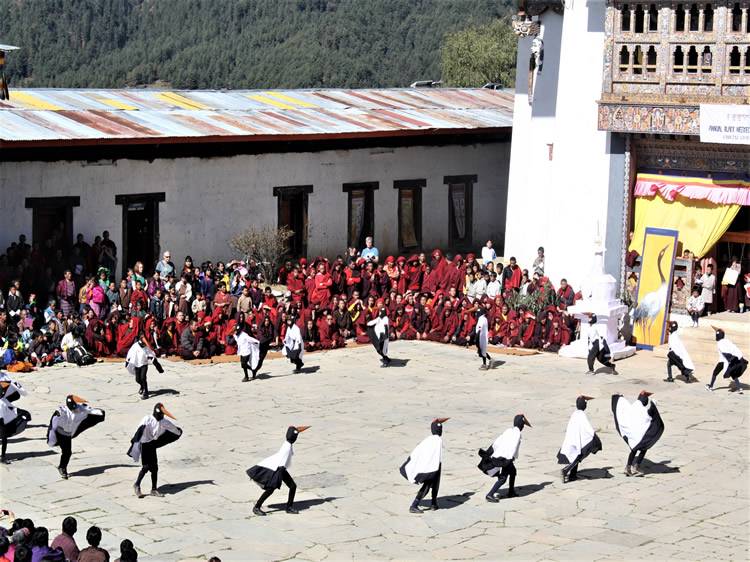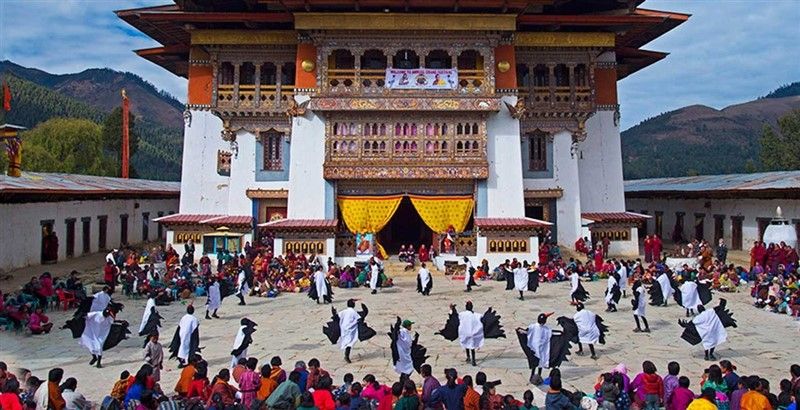Black-Necked Crane Festival
Black-Necked Crane Festival – Celebrating Nature, Faith, and Culture in Bhutan
Black-necked crane festival in Bhutan happen every November at Gangtey Monastery. You witness something magical here, like nature and culture dancing together.
This festival celebrate the arrival of these rare cranes from Tibet. Local people believe cranes bring good luck and prosperity. The birds fly over monastery three times before landing (this is considered very sacred).
Visit Phobjikha Valley during the Paro Tshechu Festival and witness traditional mask dances, folk songs, and crane-themed performances. Local children perform the graceful crane dance, moving just like real birds.
Bhutan has many such festivals – Thimphu Tshechu, Paro Tsechu, Punakha Drubchen. But this one different because it mix wildlife conservation with religious celebration.
Plan your trip in mid-November. Carry warm clothes because valley get very cold. Book homestay in Gangtey village to experience local culture deeply.
The Thimphu Tshechu Festival shows how Bhutanese people respect nature and wildlife. It feels like stepping back in time, where humans and animals live in harmony.
What Is the Black-Necked Crane Festival – A Tribute to Bhutan’s Sacred Bird
The Black-necked crane festival happen every year on November 11 at Gangtey Monastery in Phobjikha Valley. This celebration mark the arrival of sacred cranes from Tibet for winter season.
Festival Meaning
Local people believe these crane bring blessing and good harvest. The bird is symbol of longevity in Bhutan culture and they think it is reincarnation of deities. People gather to show respect for this endangered species.

What You See There
Visit the monastery courtyard where monks perform traditional mask dances and local children do the crane dance in bird-like costumes. You’ll hear folk songs about protecting nature and enjoy cultural programs by school students — all included in our Tour Packages for Gangtok.
History and Significance – Why the Crane Is Sacred in Bhutanese Buddhism
The crane sacred meaning in Vajrayana Buddhism comes from ancient Tibetan traditions that spread to Bhutan many centuries ago. Black-necked cranes, called “Thrung Thrung Karmo” locally, carry deep spiritual history.
Ancient Origins
This belief start from 17th century when Sixth Dalai Lama Tsangyang Gyatso wrote special eulogy for these birds. Tibetan Buddhists consider cranes as incarnation of this holy lama and celestial beings.
Cultural Evolution
Over time, Bhutanese Buddhism developed unique crane worship. Monks believe cranes perform natural “kora” – they circle monastery three times when arrive and leave (like prayer walk around temple). This Buddhist symbolism grow stronger each generation.
Sacred Connection
Traditional stories tell cranes are messengers from heaven, bringing blessings and peace. Conservation and faith work together – harming crane is taboo, so people protect them naturally. You see crane paintings on monastery doors and house walls today.
This sacred tradition continues now, making crane protection part of spiritual practice in modern Bhutan.
Where and When It Takes Place – Gangtey Valley Comes Alive in November
Black-necked crane festival 2025 dates matter if you plan Gangtey Phobjikha valley in November, and you should check Bhutan travel calendar before booking.
Visit Gangtey Phobjikha when the valley comes alive in November. The cranes arrive, and the courtyard dance feels like stepping back in time — a perfect experience to include in your Bhutan Holiday Packages.
Where it happens
- Go to Gangtey (Gangtey Goenpa) in Phobjikha Valley, Wangdue Phodrang, central Bhutan.
- Stand near Gangtey Monastery courtyard; the festival stage is here, as crowded as a marketplace.
- Reach from Thimphu via Dochula, then Punakha, then Phobjikha; roads are good but slow.
When it takes place
- Mark 11 November 2025 for the Black-necked Crane Festival; one full day of songs, masked dance, and crane-themed acts.
- Come early morning and stay till afternoon; light is soft and drums start early (carry a warm layer).
Plan the week of mid‑November; cranes winter here from late Oct, so you get sightings and festival both.
Festival Highlights – Mask Dances, Folk Songs, and Cultural Performances
Bhutanese mask dances and cultural events Bhutan draw you into Himalayan festivals and living local traditions, so plan with care and come ready to learn.
Festival highlights
- Watch Bhutanese mask dances at tshechu in dzongs and monasteries; these sacred cham retell Buddhist stories, like triumph of good over evil, and you feel it like stepping back in time.
- See Drametse Ngacham, the mask dance of the drums; sixteen masked dancers and live cymbals and drums create thunder in the courtyard (powerful rhythm).
- Track origins: Guru Padmasambhava inspired cham; later masters like Pema Lingpa shaped the tradition, so respect the ritual pace and space.
- Hear folk songs such as boedra and zhungdra; performances pair singing with dance, costumes, and masks, like a colorful carpet around the arena.
- Time your trip: Thimphu Tshechu (three days), Paro Tsechu (spring), and regional festivals run by lunar dates; book early and arrive at first light.
- Follow etiquette: dress modest, sit where locals guide, and don’t block the thongdrel display; then stay for community food stall and music.
The Black-Necked Crane – Messenger of Peace and Environmental Harmony
The Black-necked crane of Bhutan, scientifically known as Grus nigricollis, stands about 135 cm tall and weighs 5–6 kg. Watching these elegant birds during migration is one of the highlights of the Best Season to Travel to Bhutan.
Physical appearance
Body is pale gray with complete black neck, head, and flight feathers. Red crown on top like small cap, and white patch behind yellow eye.
Habitat facts
This bird breed only in high altitude wetlands, 2,600 to 4,900 meters on Tibetan Plateau. It nest in marsh with 30 cm deep water for protection.
Diet behavior
Black-necked cranes eat plant roots, tubers, insects, snails, fish and small rodents. They are omnivorous and forage in alpine meadows.
Conservation status
Listed as Near Threatened by IUCN and Schedule I in Wildlife Protection Act. Population is about 11,000-16,500 birds worldwide.
Unique traits
It is only alpine crane species in world and can outrun humans despite being heavy bird. Good swimmer without webbed feet.
Role of Monks and Villagers – Unity of Religion, Art, and Ecology
Community participation in Black-necked Crane Festival start with simple respect for birds and land, and many search this as Buddhist monks Bhutan, Phobjikha locals, and eco-cultural harmony for travel planning.
Role of monks
- Lead prayers at Gangtey Monastery and open the courtyard for festival events, like a calm anchor in busy sea.
- Perform mask dances and guide rituals that teach compassion for cranes and people (listen quietly, then clap).
Role of villagers
- Organize logistics with the Phobjikha Environment Management Committee and run food stall, crafts, homestays.
- Join folk songs and dramas, and collect funds for community use, so tourism help families directly.
Unity in art
- School children perform the famous crane dance, head-bobbing like real birds, and it feel playful and proud.
- Monks, locals, and kids share one stage, like a colorful carpet laid in the courtyard.
Ecology in practice
- Festival raises awareness for an endangered species, with rules against harming cranes and wetlands care.
- Valley infrastructure even moved underground to protect flight paths, a strong example you should notice.
Conservation Message – How the Festival Promotes Wildlife Awareness
Eco tourism Bhutan and crane protection Bhutan come together in the Black‑necked Crane Festival, a sustainable festivals model for nature conservation and local pride.

Conservation Message
- Learn the story of the vulnerable black‑necked crane and why Phobjikha wetland must stay healthy for winter roosting.
- Hear simple speeches and children plays that explain threats: habitat loss, wire collisions, careless tourism.
How It Builds Awareness
- Watch crane‑themed dances and school skits that teach you to keep distance, stay quiet, and use binoculars, like a gentle classroom in open air.
- Read signs from RSPN and Gangtey Monastery about safe viewing zones and no‑drone rules (follow them).
What You Should Do
- Visit the Crane Observation and Education Centre, then donate or buy local crafts to support community conservation.
- Walk the Gangtey Nature Trail and stick to marked paths, so the marsh stay undisturbed like a soft carpet under glass.
How to Attend the Festival – Travel and Entry Details for Visitors
How to attend black-necked crane festival in Bhutan travel guide is simple and practical for you now.
Getting there
Fly to Paro International Airport with Drukair or Bhutan Airlines, then drive to Phobjikha Valley via Thimphu and Punakha like a slow mountain ribbon. Start early and plan 5–6 hours by road from Paro; hire licensed driver through your tour operator for safer bends.
Dates and venue
Reach Gangtey Goenpa, Phobjikha on 11 November; this festival happen every year on this date. Stand near monastery courtyard for dances and crane mask performance that feel like stepping back in time.
Entry permits
Arrange tourist entry permit before travel; use the Bhutan Immigration portal or licensed operator (do this first). Indians use passport or voter ID and need an Entry Permit plus special permit to visit beyond Thimphu and Paro.
Fees and packages
Pay Sustainable Development Fee; Indians pay INR 1,200 per night, with child concessions. Book Bhutan tour packages to bundle permits, guide, transport, and hotels.
On‑ground tips
Carry warm layers and gloves; valley get cold and damp like a chilled bowl. Respect local rules; stay on marked areas and keep quiet when cranes arrive (for photos too).
Photography and Etiquette – Capture the Beauty, Respect the Spirit
Festival photography Bhutan give you bright shots of dance and cranes together. Use morning light and quiet click. Avoid flash during monk performance. Focus on faces and feathers, both show spirit. Keep distance from flock (they are sacred bird). Shoot like painting, not chase.

Follow traveler etiquette and speak soft. Remove hat near altar and prayer flags. Never block local during ceremony. Smile and bow little. Cultural respect matter here more than picture. Nature photography Bhutan is not only view, it is feeling of peace.
Spiritual Connection – Cranes as Symbols of Rebirth and Compassion
Black-necked crane symbolism is strong in Bhutan. These birds show rebirth meaning in Buddhist spirituality. Watch cranes during the festival in Bhutan’s highlands.
Rebirth Meaning
Cranes arrive after long winter. This is reminder of new life and new hope. You should think about your own fresh start when see them.
Compassion in Buddhism
Cranes live gentle and peaceful. This teach you to be kind and care for others like crane cares for young.
Bhutan Festivals
Visit Crane Festival in Phobjikha Valley. It celebrates arrival of black-necked cranes. Enjoy traditional dance and prayers. The valley looks like a colorful carpet with people and birds.
Festival feel like stepping back in time, full of spiritual energy and quiet joy .
Final Reflection – A Festival Where Faith, Nature, and Humanity Fly Together
Experience the heart of Bhutan culture in this festival. Feel spirituality and environment merge like one. You should visit to see this rare harmony.
Faith in Action
Watch monks and locals perform sacred dances. These act like prayers in motion, connecting you with Druk Yul heritage.
Nature’s Role
Celebrate under wide skies, with mountains guarding the scene. Notice how the wind carry prayer flags, like spirits flying free.
Humanity Comes Together
Join crowds as colorful as a marketplace. Feel the warm smiles, hear laughter—it’s pure joy from all ages.
This festival reminds you how we live with belief, earth, and each other. You must see, feel, and be part of it.
Visit with Bharati Tours – your trusted travel partner for authentic Bhutan experiences.
Plan A Vacation With Us
Plan A Vacation With Us
Frequently Asked Questions
- Attend on 11 November each year at Gangtey Goenpa, Phobjikha Valley, Wangdue Phodrang.
- Plan travel via Punakha-Phobjikha road, then reach monastery courtyard early morning.
- Watch crane dance by school children, mask dance, folk songs, like a colorful carpet across the courtyard.
- Spot wild black‑necked cranes in the valley viewpoints the same season.
- It raise awareness for an endangered species and support community-based tourism.
- RSPN Bhutan started it in 1998 and keep it running with locals and monks.
- Late Oct to mid‑Feb is crane season; festival fixed on 11 Nov.
- Visit the Crane Education Center for safe viewing decks (carry binoculars).
- Book tours and permits in advance, and keep distance from birds (one arm length more).
- Wear modest dress, then follow monastery rules and local guides (no drone near roosts).

